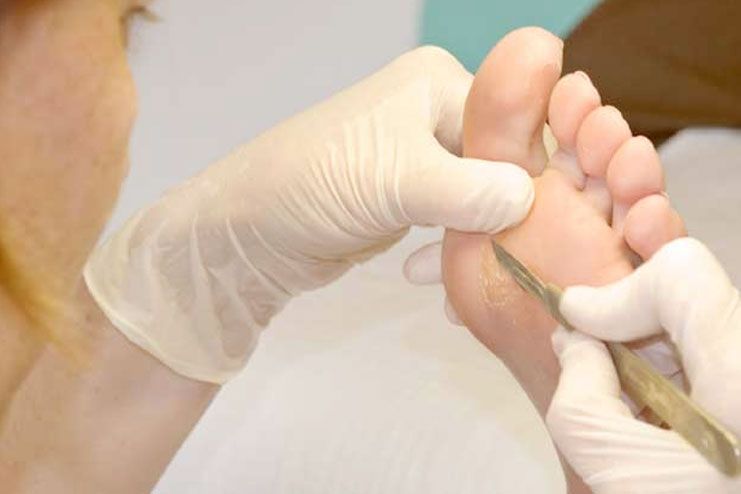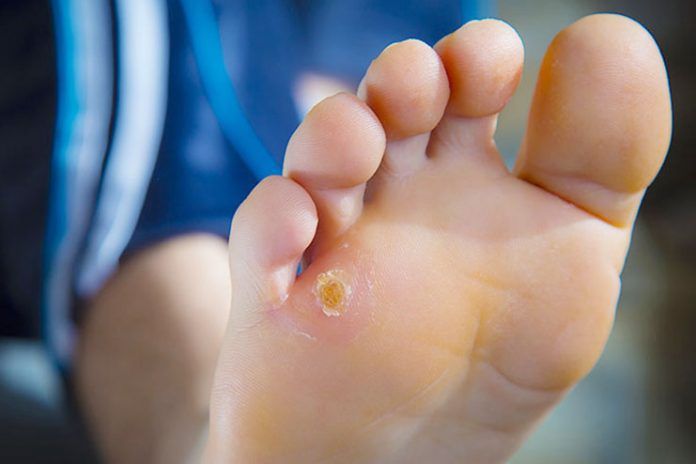Affiliate Disclaimer
Some links in this article are affiliate links. We may earn a small commission if you make a purchase through these links, at no extra cost to you. We only recommend products we find useful to our readersCorns and callusses are often confusd with some other medical condition or infection. Where as these are thickened skin areas formed usually at the prssure points on the hands and legs. This HealthSpectra post helps you learn more about this condition to take right measures.
What are Calluses And Corns?
Calluses and corns are the thick areas formed on the skin due to the friction and pressure. Pain may occur in those areas while walking or wearing shoes. Calluses are formed on the feet or hands and may not require treatment. Corns have soft or hard inner sore. Soft corns are found between toes, while hard corns are formed on the top of the toes. Poor fitting shoes are often the main reason for the formation of corns.
A callus is called as tyloma and corns are called clavi or helomas. More diffuse and flattened are of thick skin is callus, where as corn is localized and popular in conical and circular shape.
Causes For Calluses And Corns:
The medical term for the thickened skin that leads to the formation of calluses and corns is hyperkeratosis. Calluses and corns are formed due to many reasons like:
- Repeated pressure or friction on the skin due to handling heavy object like sports equipments, hammers etc are the main causes. Due to pressure,the skin forms protective, hard surface.
- At times, hard corns turn softer when the sweat gets trapped in. This occurs in between toes.
- Also walking on the barefoot and wearing the tight footwear are the culprits.
- Other reasons include sports, abnormal gait, bone structure, bone spurs, etc
Note: Corns and calluses are not formed due to viruses and are not contagious.
Where Do the Corns And Calluses Form?
Calluses and corns often form on
- bunions
- hammer
- claw
- mallet toes or on the bumps caused by rheumatoid arthritis
Risk Factors For Corns & Calluses:
People of all age groups may develop corns and calluses. Particularly, those above 65 have increased chances. Other general risk factors include:
- abnormalities in anatomy of the feet or toes;
- abnormalities in gait;
- poorly fitting shoes;
- bunions
- using equipment, tools, or instruments that exert pressure
- certain occupations
Symptoms Of Corns & Calluses Include:
- Callus appears yellowish and grayish. It is hard and dry. It may be bumping and less sensitive to touch.
- Soft corn appears as open sore, where as hard corn appears thick and firm.
- Generally they are not painful, but cause pain while wearing shoes or walking.
Diagnosis For Calluses And Corns:
People with fragile skin or poor circulation in the feet should consult medical professional as soon as corns or calluses develop. Particularly people with medical conditions such as diabetes or peripheral arterial disease should not ignore.
Physical examination by the doctor and lifestyle/ history itself is enough to diagnose calluses and corns. The doctor may ask for an R-ray if he suspects any bone damage.
How To Treat Calluses and Corns?
No treatment is needed if there is no pain. However, corns and calluses are foot problems that can be treated with several medicated products to chemically pare down the thickened, dead skin. Salicylic acid is the most common ingredient in all of them.
If the pain exists, then it can be eased by making a few lifestyle changes like wearing right fit shoes with deep and wide toe boxes so that not much pressure is applied against each other or on the toe top. Using protective padding with foot heals may also help.
1. Warm water soak:
Soak callus or corn in warm water and try to wear away the dead skin with a pumice stone. Do not cut them, especially if you are diabetic as it may cause numbness or circulatory problems.
2. Salicylic acid rub:
Soften the callus and corns with salicylic acid. However, many doctors advise against it due to the possibility of the salicylic acid damaging the surrounding skin. Do not apply the same, especially if you are diabetic.
3. Trimming:
If the callus or corn is bothering you, your doctor may trim the area with a small knife in his clinic. If the problem is severe, you may be asked to see a podiatrist.
Rarely, surgery is an option to treat corns and calluses.
Home Remedies For Corns And Calluses?
Products used as home remedies for corns and calluses include salicylic acid (keratolytic) as the active ingredient. The same ingredient is used in OTC products as well.


Salicylic acid dissolves the protein keratin that makes up most of the thick layer of dead skin it. Sacylic-acid treatments are available in different forms including
- Applicators
- pads
- drops
- plasters
All of these treatments are designed to turn the top of the skin white. They allow the dead tissue to be trimmed or peeled away, making the corn protrude.
Caution: Seek medical advice before attempting any home ready for any medical condition.
More Tips To Remove Corn And Calluses
The citric acid in lemon: It softens corns and help them eventually fall off.
- Apply fresh lemon juice to the corn
- Allow it air dry
- Repeat at least thrice a day.
or
- Mix lemon juice with a teaspoon of yeast to make a thick paste.
- Apply on the corn.
- Cover the mixture with a bandage, and leave it on overnight
- Remove next morning
Or
- Rub a garlic clove on the corn
- Allow air dry
- Cover the corn with a bandage overnight.
- Next morning wash feet with warm water.
Note: None of these home remedies are backed by research. If not sure, consult your physician before trying them.
How Can You Prevent Corns And Calluses?
Corns and calluses and can be prevented by avoiding or reducing the pressure on the skin.
- Wear gloves on hands when gardening or lifting heavy objects to avoid calluses.
- Use well-fit shoes and socks to prevent calluses on the foot.
- Follow a proper walking pattern as the way you walk can lead to corns and calluses.
- In some cases, a podiatrist may help make corrections to prevent foot problems.
In conclusion, calluses and corns are not a severe medical condition that needs treatment, unless they cause pain. They are neither infectious nor contagious. Simple lifestyle changes and adjustments may help improve the condition.































